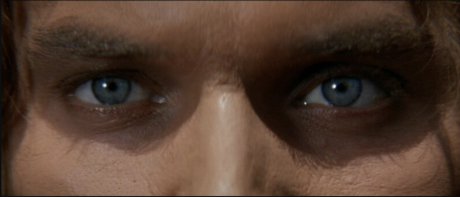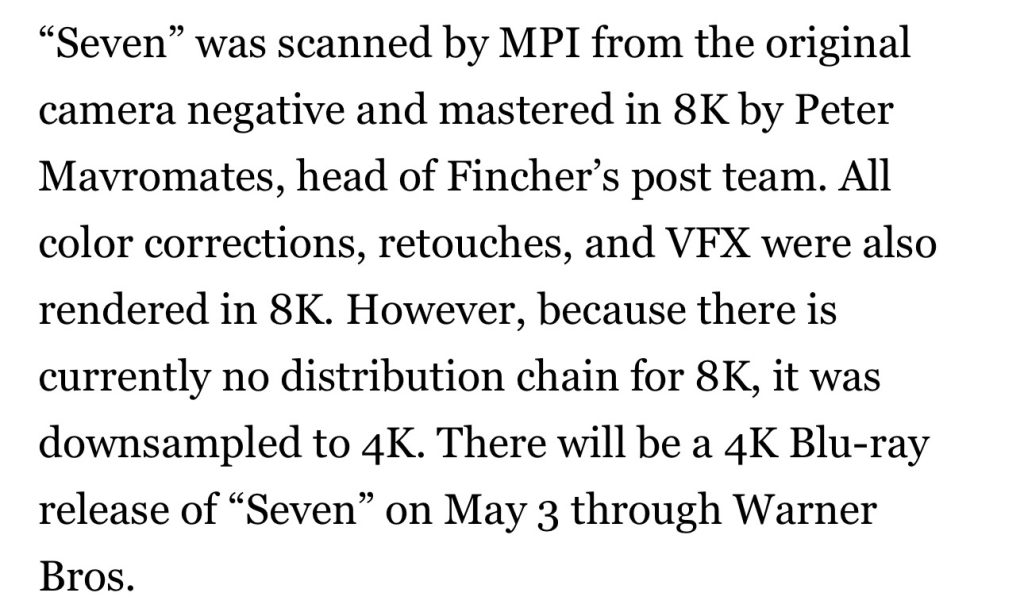The eyes are the window of the soul…
(top) Donald J. Trump; (middle) Jeffrey Hunter as Jesus H. Christ in King of Kings (’61); (bottom) Robert Ryan as John the Baptist in same film.



The eyes are the window of the soul…
(top) Donald J. Trump; (middle) Jeffrey Hunter as Jesus H. Christ in King of Kings (’61); (bottom) Robert Ryan as John the Baptist in same film.



…that I wish I’d been able to attend.
I liked Travolta better when he had some hair. The egg-bald-with-a-beard thing is okay, but not what I would call “preferred.”
I’m glad that David Fincher has spent several months restoring as well as upgrading certain aspects of Se7en…cool. I’m also glad that this effort has yielded a 4K Bluray that will pop on 5.3.
I’m sad that I can’t be there for today’s special TCM Classic Film Festival screening, but if a NYC screening happens between now and 5.3, perhaps Fincher will let the cool kidz know or put them on an invite list or something?
From 4.19 Bill Desowitz IndieWire piece:



I sadly understood when Vietnamese monks burned themselves to death in Saigon in the ‘60s, and I sadly understood when Norman Morrison self-immolated in front of the Pentagon in 1965.
But I don’t get why a guy has gone up in flames outside the building in which Mango Beast is being tried for illegally paying off Stormy Daniels and Susan MacDougal.
Maybe the burnt toast guy is some MAGA wacko, protesting the prosecution of his Lord and Savior by the Deep State?
If so, I’m thinking of a scene in The Godfather, Part II in which Michael Corleone is given pause over that Fidel Castro supporter who blows himself up and takes a Batista army officer with him. I have a bad feeling about this.
GRAPHIC:
Man sets himself on fire outside the courthouse at the Trump Trial in NY.
This MADNESS MUST END!
This entire sham trial is ripping our nation apart and causing mass scale, demonic chaos.
The left wants chaos. https://t.co/4NToi6rahr
— Mike Crispi (@MikeCrispiNJ) April 19, 2024


Okay, forget the MAGA wacko theory.
If Nancy Sinatra says no, perhaps her sister Tina feels the same way?
Anyone with any respect for the biological reality of Francis Albert Sinatra as he walked the earth in the early ‘50s would find the proposed casting of the too-tall, too-wide-faced Leonardo DiCaprio in Martin Scorsese’s Frank-Ava biopic to be absurd.
World of Reel’s Jordan Ruimy caught this first.

Variety’s Tatiana Siegel, posted on 4.17:

HE agrees with Nancy — the proposed Leo–JLaw casting doesn’t cut it:
I’m sorry but a very hotsy-totsy Hollywood screening of a 4K DCP restoration of Alfred Hitchcock‘s North by Northwest will happen two days hence, and I need to hear reactions from sophistos who can roll up their sleeves and evaluate the quality of the restoration like pros.
People have been waiting for a NXNW 4K restoration for many years. Talk about long-anticipated, pulse-quickening, etc.
What kind of a bump or enhancement does the new restoration offer, and in what way exactly? Be specific. Or is the restoration more in the realm of a sturdy, respectable capturing of what the currently purchasable Bluray already offers?
Those planning to attend the Saturday, 4.20 viewing at the TCL Chinese IMAX theatre (it starts at 2:45 pm) need to send reviews to HE as soon as possible.
44 years ago I attended a glorious Radio City Music Hall presentation of Kevin Brownlow‘s restoration of Abel Gance‘s Napoleon (’27) — a Francis Coppola-sponsored, once-in-a-lifetime cinematic happening that knocked everyone’s socks off…three 35mm projectors and a super-wide screen (those triptych sequences!), a live symphony orchestra conducted by Carmine Coppola…a magnificent trigger switch…genuinely exciting blood-pump cinema.
Many different versions of Gance’s masterpiece have been screened over the last century, and all were quite lengthy.
The world premiere version happened at the Paris Opera in April 1927, and it ran 4 hours and 10 minutes. A nine-hour version played the following month at Paris’s Apollo theatre. A six-hour, 43-minute version was sent to the U.S. in 1928. Many different cuts shown at varying film speeds were exhibited worldwide over decades. The Coppola-Brownlow version shown at RCMH in 1980 ran four hours with a longish intermission. It’s also viewable on Bluray, of course, with a running time of 333 minutes.
All to say that a brand-new Cinematheque Francaise version is premiering at next month’s Cannes Film Festival — seven hours total but shown in two parts. The first half (which will run three hours and 40 minutes) will screen on Tuesday, 5.14. HE will attend, of course.
Gance’s Napoleon is a much more vital and essential film than Ridley Scott and Joaquin Phoenix‘s Napoleon — I can tell you this without qualification. What ever happened to the idea of streaming a much longer version on Apple?
I never saw Jeannot Szwarc and Carl Gottleib‘s Jaws 2 (’78) because I knew it would be dogshit.
Even though it was produced by Richard D. Zanuck and David Brown and costarred Roy Scheider, Lorraine Gary and Murray Hamilton, it was obviously corned beef hash. But before today, I had never seen a frame of it, and I must say that the water-ski-attack-meets-exploding-motorboat scene is hilarious!
Is there another scene as ludicrous? Does Hamilton’s mayor character get eaten? Answer: No — Murray is spared.
Jaws 2 cost $30 million to produce; it wound up earning $102,922,376 domestic and $105,978,000 foreign for a total of $208,900,376.
Richard Linklater‘s caper-esque Hit Man premiered…what was it, seven months ago? The big debut happened at last September’s Venice Film Festival, then a couple of weeks later at the Toronto Film Festival (where Netflix picked it up) and then the New York Film Festival.
Everyone loved Hit Man — the most popular light-hearted thriller of 2023. And then it kinda dropped out of sight, at least as far as advance screenings were concerned. Those not paying close attention might have thought it had opened. It never did, of course.
And now it’s back! Back to the future! One of 2023’s most likable hit movies is opening theatrically on May 24th, and will begin streaming on Netflix on June 7th.
I did a sitdown interview with Brian Wilson and then-fiance Melinda Ledbetter during the 1995 Sundance Film Festival. We were supposed to talk about Don Was‘s documentary about Wilson, I Just Wasn’t Made For These Times, which was having its big premiere up there, but we went all over.
I remember telling Wilson that I always loved the reverb guitar-and-keyboard intro for ““The Little Girl I Once Once Knew,” and he quickly agreed. (That same year he told a British interviewer that “the intro is the only good part of it.”) I then told Wilson how I once tried to learn to play the intro on keyboard but I couldn’t “hear” the separate harmonized notes in my head.
Wilson responded with disappointment and even a lack of patience — “You couldn’t figure that out?” That’s how geniuses are. When the stars are aligned they can swoop right in and solve any riddle, and if they’re in any kind of mood people who lack their gift can seem…I don’t know, tedious?
After seeing Love & Mercy I decided to buy a few songs from The Beach Boys Today!, which was recorded a little more than a year before Pet Sounds.
Today! is occasionally experimental and in some ways a kind of Pet Sounds forerunner. It contains similar elements — sophisticated off-rhythms and swirling harmonies, a feeling of sadness and vulnerability in the lyrics, that symphonic white soul thing — that Wilson built upon and made into something extra with Pet Sounds.
The track that knocked me out was “Kiss Me Baby.” It’s not so much a love song as a “we almost broke up last night so let’s not get that close to Armageddon again!” song.
The melody is a bit on the plain and familiar side, but the lyrics are so child-like and emotionally arrested…an immature boy-lover recovering from nearly losing his mommy-lover: “Please don’t let me argue any more…I won’t make you worried like before…can’t remember what we fought about…late, late last night we said it was over,” etc.
But when the chorus kicks in the harmonies and the general meltdown sound of this song are just amazing. This was Wilson’s unique realm — he made it sound just so, and with such exquisite balance and texture.
This instrumental track for “Let Him Run Wild” is also interesting for its resemblance to the instrumental Pet Sounds Sessions tracks.
On 11.23.11 or 12 and 1/2 years ago I wrote that Martin Scorsese and Leonardo DiCaprio (then 37) were apparently seriously interested in a Frank Sinatra biopic with Leo playing the relatively short-statured Hoboken crooner.
I was relieved when this idea fell by the wayside as DiCaprio’s physical characteristics don’t even vaguely echo Sinatra’s (zero facial resemblance, Leo is way too tall and not skinny enough, the timbre of their speaking voices couldn’t be further apart).
But now this crazy idea is back again with Variety’s Tatiana Siegel filling in some of the details.
The focus will be on the volatile early ‘50s chapter of Sinatra’s career (seriously slumping as a singer and an actor, embroiled in a torrential marriage to Ava Gardner) and how he was finally rescued and restored by his Pvt. Maggio performance in From Here to Eternity (‘53).
Except the about-to-turn-50 Leo (DOB: 11.11.74) is too old to play Sinatra in his late 30s, plus he’s still the wrong size and shape and everything else.
Plus Jennifer Lawrence can’t possibly pull off an Ava Gardner performance…not in the cards.